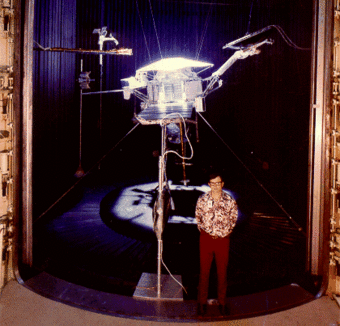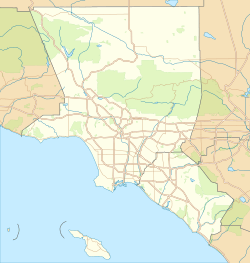Twenty-Five-Foot Space Simulator facts for kids
|
Twenty-Five-Foot Space Simulator
|
|

Mariner 10 in the Twenty-Five-Foot Space Simulator
|
|
| Location | Jet Propulsion Laboratory, Pasadena, California |
|---|---|
| Area | less than one acre |
| Built | 1961 |
| Architect | NASA |
| NRHP reference No. | 85002812 |
Quick facts for kids Significant dates |
|
| Added to NRHP | October 3, 1985 |
| Designated NHL | October 3, 1985 |
The Twenty-Five-Foot Space Simulator is a special room built to test spacecraft. It creates conditions like those in outer space. This includes extreme cold, strong radiation, and almost no air.
This simulator was built in 1961. It is located at the Jet Propulsion Laboratory in Pasadena, California. Many American space probes were tested here before they launched. In 1985, it was named a National Historic Landmark. This means it is a very important historical place.
Contents
What is the Twenty-Five-Foot Space Simulator?
The Twenty-Five-Foot Space Simulator is a huge cylinder made of stainless steel. It stands about 85 feet (26 meters) tall. It is also about 27 feet (8.2 meters) wide.
How Do Spacecraft Enter the Simulator?
There is a large door that is 15 feet (4.6 meters) wide and 25 feet (7.6 meters) high. This door allows large test objects and equipment to enter the chamber. A smaller door for people is built into the big one.
What Conditions Can the Simulator Create?
The walls and floor of the simulator have special cooling systems. These can change the temperature from a very cold -320°F (-196°C) to a hot 200°F (93°C).
The simulator also has lamps, lenses, and mirrors. These can create a strong beam of light. This light acts like sunlight in space. The chamber can also remove almost all the air inside. This creates a near-vacuum, just like in space.
How Long Does It Take to Prepare the Simulator?
It takes about 75 minutes to make the simulator feel like space. To return it to normal conditions, it takes about 2 and a half hours. The floor of the chamber is built on a special base. This base helps protect it from vibrations.
Why is the Space Simulator Important?
When it was built in 1961, this simulator was the only one of its kind. It was a groundbreaking facility for space exploration.
Which Spacecraft Were Tested Here?
Many famous spacecraft were tested in this simulator. These include:
The Twenty-Five-Foot Space Simulator also served as an example. Other countries used it as a model when they started their own space programs.




